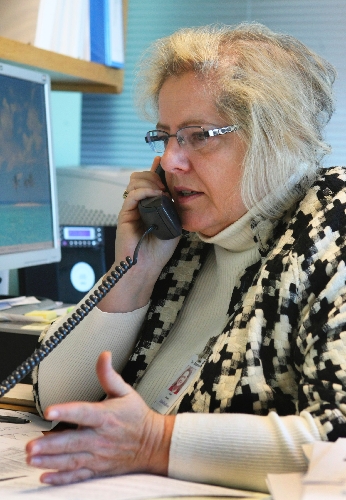Health, Nevadans poles apart
First, some good news from the 2010 edition of America's Health Rankings: Since 2000 the prevalence of smoking in Nevada has decreased from 31.5 percent to 22 percent of the population.
Now for some not-so-good news: Although Nevadans are breaking a habit that increases the likelihood of everything from lung cancer to heart attack, the state's percentage of people lighting up is still more than double that of Utah, where people are the least likely to take a drag on a Camel.
And now for some really lousy news from the annual survey, released today , that analyzes behaviors, public and health policies, community and environmental conditions and clinical care data: Out of 50 states, Nevada rates 47th, a drop of two places since last year.
Dr. Linda Johnson, president of Las Vegas' Southwest Medical Associates, chooses not to dwell on the negative.
"I think the medical community can come away from this report recognizing the opportunities," she said Monday. "It helps us target where to put our efforts. We educated people about smoking, and it has worked."
She also thinks that a ban on smoking in many public places approved by voters in 2006 contributed to the improvement.
Southwest Medical Associates is a clinical arm of United Health Group, a health care company with a family of businesses serving more than 75 million people worldwide. One of the company's foundations, the United Health Foundation, publishes America's Health Rankings in a partnership with the American Public Health Association and Partnership for Prevention.
Now in its 21st year, the report is the longest-running annual assessment of the nation's health on a state-by-state basis. Johnson said it serves as a snapshot to help educate people about how to improve public health across the nation.
The entire report is available at www. americashealthrankings.org.
What makes this health report different from others is that it takes into account behaviors that include graduation from high school and violent crime, categories in which Nevada finished dead last.
"Studies have shown that the more educated a community is, the better health choices they will make," Johnson said, adding that violent crime reflects a disturbing aspect of current lifestyle and is an indicator of health risk and death ranging from illegal drug use to murders, rapes and robberies.
According to the report, which uses the latest state and national government statistics, the percent of Nevada ninth-graders who graduate within four years is 52.0, far below Wisconsin's top ranking of 88 percent.
"When times were good here in construction and the casinos, young people thought you didn't need an education," Johnson said. "I have a feeling with today's economy that's going to change now. We need to really educate people on this."
Nevada's 700 violent offenses per 100,000 population is more than three times the fewer than 200 offenses per 100,000 population of the states with the least crime: Maine, Vermont, New Hampshire and South Dakota.
Johnson said she sees the state's crime statistics as a possible indicator of a harsh economy. Yet while Nevada was booming in 2004, the state was ranked 44th, with 637 offenses per 100,000 population.
Though Dr. Mitchell Forman, president of the Clark County Medical Society, said it is sometimes difficult to interpret a report's statistics, he said the current survey can help "educate the public and physicians."
"We need to learn where to better coordinate our efforts in the community," he said.
That in the past five years the prevalence of obesity increased from 21.1 percent to 26.4 percent of Nevada's population has to make people sit up and take notice, he said.
More education and aggressive treating of obesity is necessary, he said, or a myriad health problems from diabetes to heart problems will grow even faster than predicted by many in the medical community.
Forman is cautious about interpreting statistics showing that since 1990, the rate of deaths from cardiovascular disease decreased from 408.8 to 299.0 deaths per 100,000 population.
"They may be alive -- we can keep them alive longer -- but they're also much sicker," he said. "The report doesn't say how those people are living."
Johnson is far more positive about the statistics as they pertain to cardiovascular disease, suggesting that the evidence shows physicians are treating people more effectively for conditions such as high blood pressure.
The report shows that 19.8 percent of Nevadans do not have health insurance -- only three states have a higher number -- and less than 74 percent of women receive early prenatal care, which ranks 49th in the nation.
Again, Johnson sees an economy in which the unemployment rate is nearly 15 percent and the underemployment rate nearly 20 percent as the reason. But in 2004, nearly 19 percent didn't have health insurance, and only 70 percent of women received prenatal care.
"The fact that construction work makes for a largely a transient population also has something to do with it, "Johnson said, adding that people and families who go from state to state to find work often do not have insurance or a regular doctor for health care.
Johnson said there is no question why Nevada ranks last in public health funding, at $39 per person, compared with more than $150 per person in West Virginia, Vermont, Alaska and Hawaii.
"It speaks to our state's economy," she said. "It's not seen as a priority budget item," she said.
Why the state fares so poorly in immunizations of children ages 19 to 35 months -- Nevada ranks 49th, with 83 percent of children getting vaccinated -- puzzles Johnson. Often such immunizations can be gotten free or at a reduced cost.
"We need to do a better job of educating," she said. "I think there is a desire there by parents to get it done but not an understanding of how to do it."
The report also notes the lack of primary care physicians in Nevada; the state's 86.2 per 100,000 population is not even half of the number in Massachusetts.
Dr. Ivan Goldsmith, an internist, said one reason the number is low is because United Healthcare Insurance, the insurance arm of United Health Group, pays a low reimbursement to physicians for the care of patients.
"And the number is going to get lower here if the reimbursement rates to doctors for care don't go up," he said.
Goldsmith said physicians and consumers were hurt when United Health Group was allowed to acquire Sierra Health Services a couple of years ago, increasing United Healthcare and its affiliates' market share to about 35 percent in Southern Nevada. The insurance group also has about 50 percent of the Medicare Advantage market.
"When you have just a few companies, you get rid of competition," he said. "They keep raising insurance rates but not reimbursements to physicians."
Johnson sees the problem differently. She said that before the state's malpractice reform law took hold a couple of years ago, primary care physicians didn't want to come to the state because of the high cost of malpractice insurance.
It's still difficult to attract young physicians here, she said, because they often want to practice where they went to school or where their families are.
The University of Nevada School of Medicine graduates about 60 doctors per year.
Johnson sees reason for optimism in Nevada's health care system.
She said the health care overhaul voted into place by Congress will give people more access to health care. Although that will mean that nurse practitioners and physician assistants will see many more patients in the future, she said she thinks Nevadans and Americans in general will support that.
"They realize that physicians will be taking care of the sicker patients," she said. "They'll be OK with that. They'll be getting the level of care they need for routine health maintenance."
Contact reporter Paul Harasim at pharasim@reviewjournal.com or 702-387-2908.
TOP FIVE
1. Vermont
2. Massachusetts
3. New Hampshire
4. Connecticut
5. Hawaii
BOTTOM FIVE
46. Oklahoma
47. Nevada
48. Arkansas
49. Louisiana
50. Mississippi




























